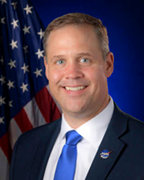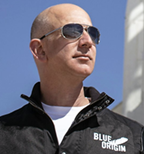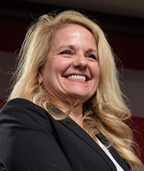
The 70th International Astronautical Congress (IAC 2019, Washington, DC) landed on U.S. soil for the first time in 17 years (53rd IAC 2002, Houston) to celebrate man’s first steps on the Moon 50 years ago and the latest breakthroughs enabling new sci-fi-like missions back to the lunar surface and beyond.
When the Trump Administration directed NASA to return man to the Moon by 2024, four years ahead of schedule, NASA responded with its Artemis plan — leveraging the best available technologies and programs, corporate/government collaborations, and commercial launch vehicles to make it happen.

U.S. Vice President,
Mike Pence.
The Artemis vision was on full display at IAC 2019, where Vice President Mike Pence opened the annual convention with a renewed call for American leadership in space exploration through cooperation with other nations. “We will use all legal and diplomatic means to create a stable and orderly space environment that drives opportunity, creates prosperity and ensures our security on Earth,” he said, speaking to the event’s massive international audience.

Jim Bridenstine
“We need international partners. We can all do more when we work together,” NASA Administrator Jim Bridenstine said during an IAC panel session pitch aimed at recruiting International Space Station partners to help land humans on the Moon in record time. “If we’re accelerating the Moon landing, we are accelerating the Mars landing,” which he suggested can be accomplished by 2035.
It will take cooperation among commercial competitors, as well, to turn a lofty plan into reality.

Jeff Bezos
“I am excited to announce that we have put together a national team to go back to the Moon,” Blue Origin founder Jeff Bezos told attendees, unveiling plans to work with Lockheed Martin, Northrop Grumman and Draper to develop NASA’s lunar lander.
SpaceX aspires to get the company’s new Starship spacefaring vehicle to orbit within the next year.

Gwynne Shotwell
“We definitely want to land it on the Moon before 2022,” SpaceX President and COO Gwynne Shotwell shared during an interview at IAC. “We want to stage cargo there to make sure that there are resources for the folks that ultimately land on the Moon.”

Tory Bruno
ULA President and CEO Tory Bruno agreed that ambitious initiatives will deliver.
“We’re going to see that Artemis puts tremendous permanent infrastructure in place around the Moon that is going to enable new and exciting commercial activities on the lunar surface and in cislunar space,” Bruno said during an interview with Satnews. “That is going to be the next giant leap for decades to come,” he declared, noting technological advancements or “big steps” are being made every day at ULA and across the industry to make space access more efficient and affordable.
Enabling Easier Access to Space
ULA is gearing up to facilitate a much higher launch frequency both at its rocket factory and on its launch pad 41 at Cape Canaveral. ULA’s Centaur 3 upper stage “is a handcrafted high performance work of art with 180,000 welds,” said Bruno. “To have our new Centaur 5 built and inspected with robotics, that’s pretty cool and affords us much bigger scale.”
As ULA transitions from its smaller Atlas rocket to the larger Vulcan Centaur, the company will launch both from the same pad for a few years, starting in 2021 when the first Vulcan Centaur is scheduled to lift Astrobotic’s Peregrine lunar lander to the Moon.
“The pad can handle a big rocket like Vulcan and a smaller rocket like Atlas the next day. That took a bit of cleverness,” Bruno noted, “We’re not aware there’s ever been a pad flying two different rockets.”
While man’s return to the lunar surface, the colonization of the Moon and manned missions to Mars may be the next giant leaps in space, countless developments by entrenched players like ULA and new space entrants such as small launch vehicle providers Rocket Lab and Firefly Aerospace are major steps in their own right — paving the way for immeasurable innovation.
To read this entire informative article, please access the upcoming November issues of SatMagazine and MilsatMagazine.
Story by Paul Sims, Contributing Editor.
Paul is an award-winning reporter and industry professional with Sims Communications,
where he specializes in traditional and new space, satellite, and connectivity markets.
For more information about Sims Communications, visit...
www.simscomm.com.

